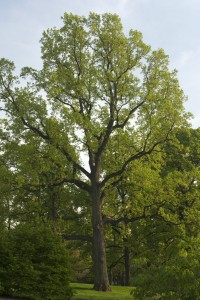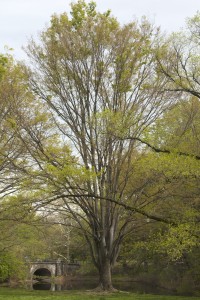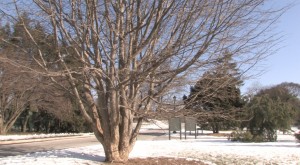Special Trees to See at the Garden
Posted in Gardens and Collections on April 29 2010, by Plant Talk
For Arbor Day, Staff Name Some Favorites; Tell Us Yours
 Carol Capobianco is Editorial Content Manager at The New York Botanical Garden.
Carol Capobianco is Editorial Content Manager at The New York Botanical Garden.
In honor of Arbor Day tomorrow, I asked some of the Horticulture staff to divulge their favorite tree at the Garden. With over 30,000 trees to select from, this could be daunting. For some, it was a cinch and they rattled off a tale about a special specimen. For others, it was like picking a favorite child, so they gave several choices.
Todd Forrest, Vice President for Horticulture and Living Collections, judiciously noted: “My favorite tree is always the one we just planted, because it helps ensure that our historic landscape will have trees for people to enjoy for decades to come.” (But he later did offer up a name, see below.)
Here, then, are some exceptional trees at the Garden and the reasons why they made the grade. Let us know which of the thousands of trees at the Garden—and we keep planting additional ones—is your favorite. We’d love to hear from you.
Todd Forrest, Vice President for Horticulture and Living Collections
Twin white oaks (Quercus alba), by the Nolen Greenhouses. They are ancient and beautiful beyond description
Jessica Arcate Schuler, Manager of the Forest
 Tuliptree (Liriodendron tulipifera), outside the Library building. This “Mother Tulip” (left) predates the Garden, is a magnificent specimen, and is what led to choosing tuliptrees for the Library Allée.
Tuliptree (Liriodendron tulipifera), outside the Library building. This “Mother Tulip” (left) predates the Garden, is a magnificent specimen, and is what led to choosing tuliptrees for the Library Allée.
Swamp white oak (Quercus bicolor), a spectacular tree in the heart of the Forest. It was one of the first I saw at the Garden.
Turkish filbert (Corylus colurna), Mosholu Gate. This unique, beautiful species is a recommended street tree and should be used more often. An interesting tree to watch all four seasons, it is one of the first trees to bloom in spring with long chain-like catkins.
American elm (Ulmus americana), Benenson Ornamental Conifers, Azalea Garden, and Spicebush Trail in the Forest. We have beautiful elm trees that are sacred relics of what used to be here. There is nothing that compares to the beauty and form of an American elm—the bark, the buttress roots—and it’s among the first species to bloom in spring!
Sweet birch (Betula lenta), a major tree in our Forest. It has a pretty metallic bark, twigs that smell of sweet wintergreen, and it was used to make birch beer.
 Common sassafras (Sassafras albidum), Twin Lakes. These mature specimens (right) are the largest I’ve ever seen. Sassafras are just cool trees with three different leaf shapes, gorgeous dark and furrowed bark, fall color, and it is where root beer came from.
Common sassafras (Sassafras albidum), Twin Lakes. These mature specimens (right) are the largest I’ve ever seen. Sassafras are just cool trees with three different leaf shapes, gorgeous dark and furrowed bark, fall color, and it is where root beer came from.
Wayne Cahilly, Manager, Lionel Goldfrank III Institutional Mapping Department
Upright European beech (Fagus sylvatica ‘Fastigiata’), outside the Watson Building, on the loading-dock side
In 1985 Rupert Barneby, who was on the Science staff here for many years, pointed out to me a Serbian Spruce in this location that replaced an upright beech tree, which grew there but much too close to the wall. He could see it from his office window and thought from time to time that it would have been a good thing had the tree been planted in the center of the lawn, rather than against the wall. He noted that he was saddened the day the beech tree was removed and the spruce, a tree of no particular aesthetic value, was planted in its place. Many years later and long after the demise of the spruce, I had the opportunity as grounds manager to select the location for a young, upright European beech and remembered Mr. Barneby and his story. I had the tree placed in the middle of the patch of lawn where it could develop for many years outside of Mr. Barneby’s window and without conflict with the building. Some weeks later I encountered Mr. Barneby and was hailed by uncharacteristic enthusiasm regarding the return of the beech.
Every time I come and go from the Watson Building, I think of Mr. Barneby, a quiet man, a careful student of plants, an instructor of many, and a man excited all out of character over the planting of that tree.
Jon Peter, Plant Records Manager
 Persian parrotia (Parrotia persica), three great specimens—one at the Benenson Ornamental Conifers parking lot (left), one on Conservatory Drive behind the Conservatory, and one behind the picnic pavilions—all from the same accession, which was received in 1906.
Persian parrotia (Parrotia persica), three great specimens—one at the Benenson Ornamental Conifers parking lot (left), one on Conservatory Drive behind the Conservatory, and one behind the picnic pavilions—all from the same accession, which was received in 1906.
These three trees are probably some of the oldest and largest parrotia in North America, a species naturally found only in the Hyrcanian region of Iran. The only known older and larger specimen (planted in 1880) grows at the Arnold Arboretum of Harvard University, the first ever planted in North America and probably from where the Garden’s trees descend. Parrotia persica is a great four-season, medium-size tree that has dark-purple flowers in early spring, green leaves in summer, multicolors in fall, and exfoliating bark that is amazing in all seasons but especially in winter.


My favorite is the Tanyosho Pine Tree. The clay-colored bark is amazing. This evergreen tree looks stunning in every season throughout the year.